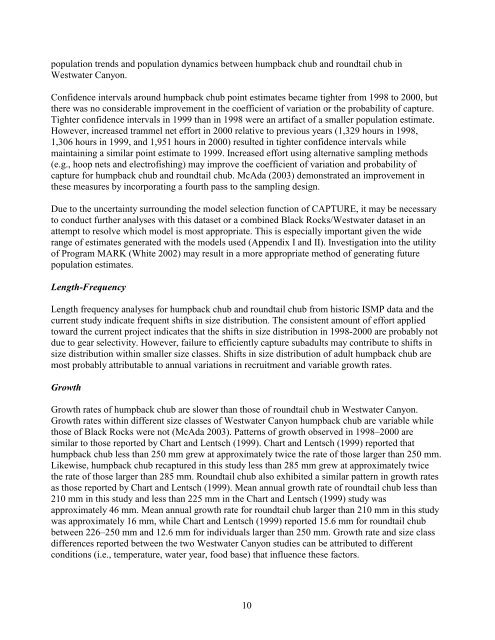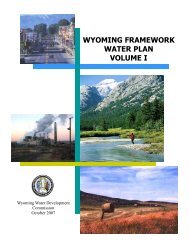population estimates for humpback chub - Upper Colorado River ...
population estimates for humpback chub - Upper Colorado River ...
population estimates for humpback chub - Upper Colorado River ...
You also want an ePaper? Increase the reach of your titles
YUMPU automatically turns print PDFs into web optimized ePapers that Google loves.
<strong>population</strong> trends and <strong>population</strong> dynamics between <strong>humpback</strong> <strong>chub</strong> and roundtail <strong>chub</strong> in<br />
Westwater Canyon.<br />
Confidence intervals around <strong>humpback</strong> <strong>chub</strong> point <strong>estimates</strong> became tighter from 1998 to 2000, but<br />
there was no considerable improvement in the coefficient of variation or the probability of capture.<br />
Tighter confidence intervals in 1999 than in 1998 were an artifact of a smaller <strong>population</strong> estimate.<br />
However, increased trammel net ef<strong>for</strong>t in 2000 relative to previous years (1,329 hours in 1998,<br />
1,306 hours in 1999, and 1,951 hours in 2000) resulted in tighter confidence intervals while<br />
maintaining a similar point estimate to 1999. Increased ef<strong>for</strong>t using alternative sampling methods<br />
(e.g., hoop nets and electrofishing) may improve the coefficient of variation and probability of<br />
capture <strong>for</strong> <strong>humpback</strong> <strong>chub</strong> and roundtail <strong>chub</strong>. McAda (2003) demonstrated an improvement in<br />
these measures by incorporating a fourth pass to the sampling design.<br />
Due to the uncertainty surrounding the model selection function of CAPTURE, it may be necessary<br />
to conduct further analyses with this dataset or a combined Black Rocks/Westwater dataset in an<br />
attempt to resolve which model is most appropriate. This is especially important given the wide<br />
range of <strong>estimates</strong> generated with the models used (Appendix I and II). Investigation into the utility<br />
of Program MARK (White 2002) may result in a more appropriate method of generating future<br />
<strong>population</strong> <strong>estimates</strong>.<br />
Length-Frequency<br />
Length frequency analyses <strong>for</strong> <strong>humpback</strong> <strong>chub</strong> and roundtail <strong>chub</strong> from historic ISMP data and the<br />
current study indicate frequent shifts in size distribution. The consistent amount of ef<strong>for</strong>t applied<br />
toward the current project indicates that the shifts in size distribution in 1998-2000 are probably not<br />
due to gear selectivity. However, failure to efficiently capture subadults may contribute to shifts in<br />
size distribution within smaller size classes. Shifts in size distribution of adult <strong>humpback</strong> <strong>chub</strong> are<br />
most probably attributable to annual variations in recruitment and variable growth rates.<br />
Growth<br />
Growth rates of <strong>humpback</strong> <strong>chub</strong> are slower than those of roundtail <strong>chub</strong> in Westwater Canyon.<br />
Growth rates within different size classes of Westwater Canyon <strong>humpback</strong> <strong>chub</strong> are variable while<br />
those of Black Rocks were not (McAda 2003). Patterns of growth observed in 1998–2000 are<br />
similar to those reported by Chart and Lentsch (1999). Chart and Lentsch (1999) reported that<br />
<strong>humpback</strong> <strong>chub</strong> less than 250 mm grew at approximately twice the rate of those larger than 250 mm.<br />
Likewise, <strong>humpback</strong> <strong>chub</strong> recaptured in this study less than 285 mm grew at approximately twice<br />
the rate of those larger than 285 mm. Roundtail <strong>chub</strong> also exhibited a similar pattern in growth rates<br />
as those reported by Chart and Lentsch (1999). Mean annual growth rate of roundtail <strong>chub</strong> less than<br />
210 mm in this study and less than 225 mm in the Chart and Lentsch (1999) study was<br />
approximately 46 mm. Mean annual growth rate <strong>for</strong> roundtail <strong>chub</strong> larger than 210 mm in this study<br />
was approximately 16 mm, while Chart and Lentsch (1999) reported 15.6 mm <strong>for</strong> roundtail <strong>chub</strong><br />
between 226–250 mm and 12.6 mm <strong>for</strong> individuals larger than 250 mm. Growth rate and size class<br />
differences reported between the two Westwater Canyon studies can be attributed to different<br />
conditions (i.e., temperature, water year, food base) that influence these factors.<br />
10
















